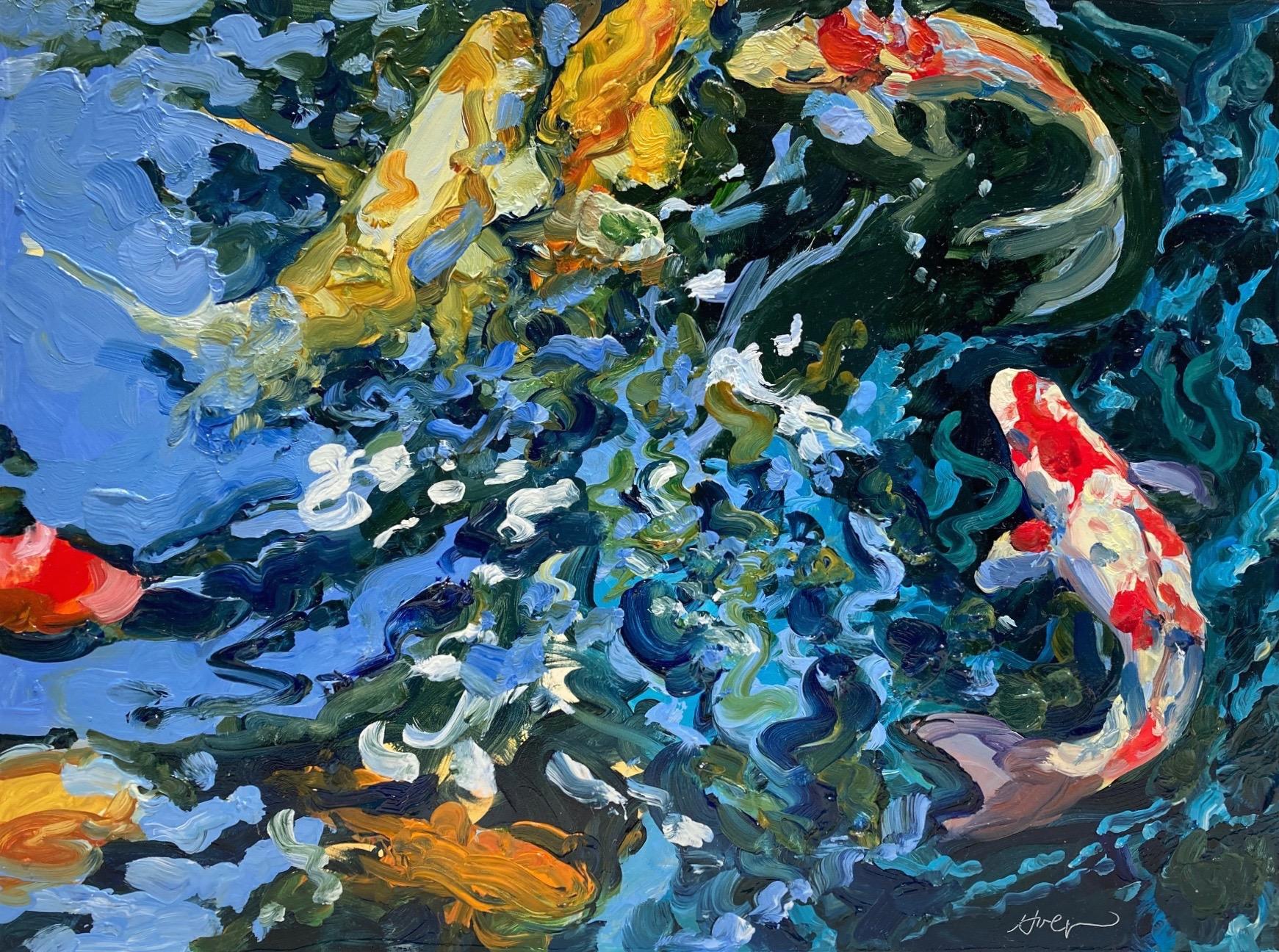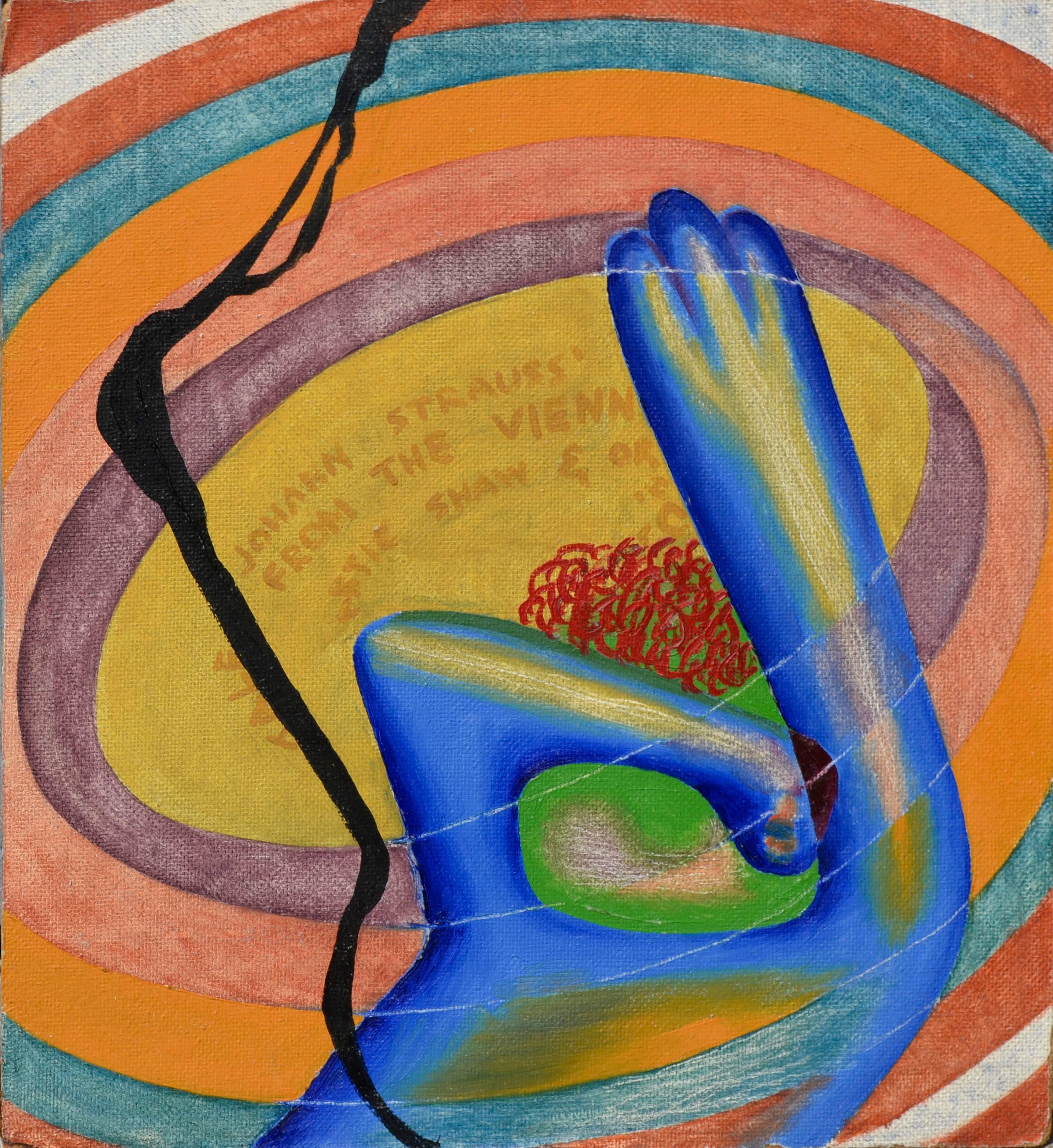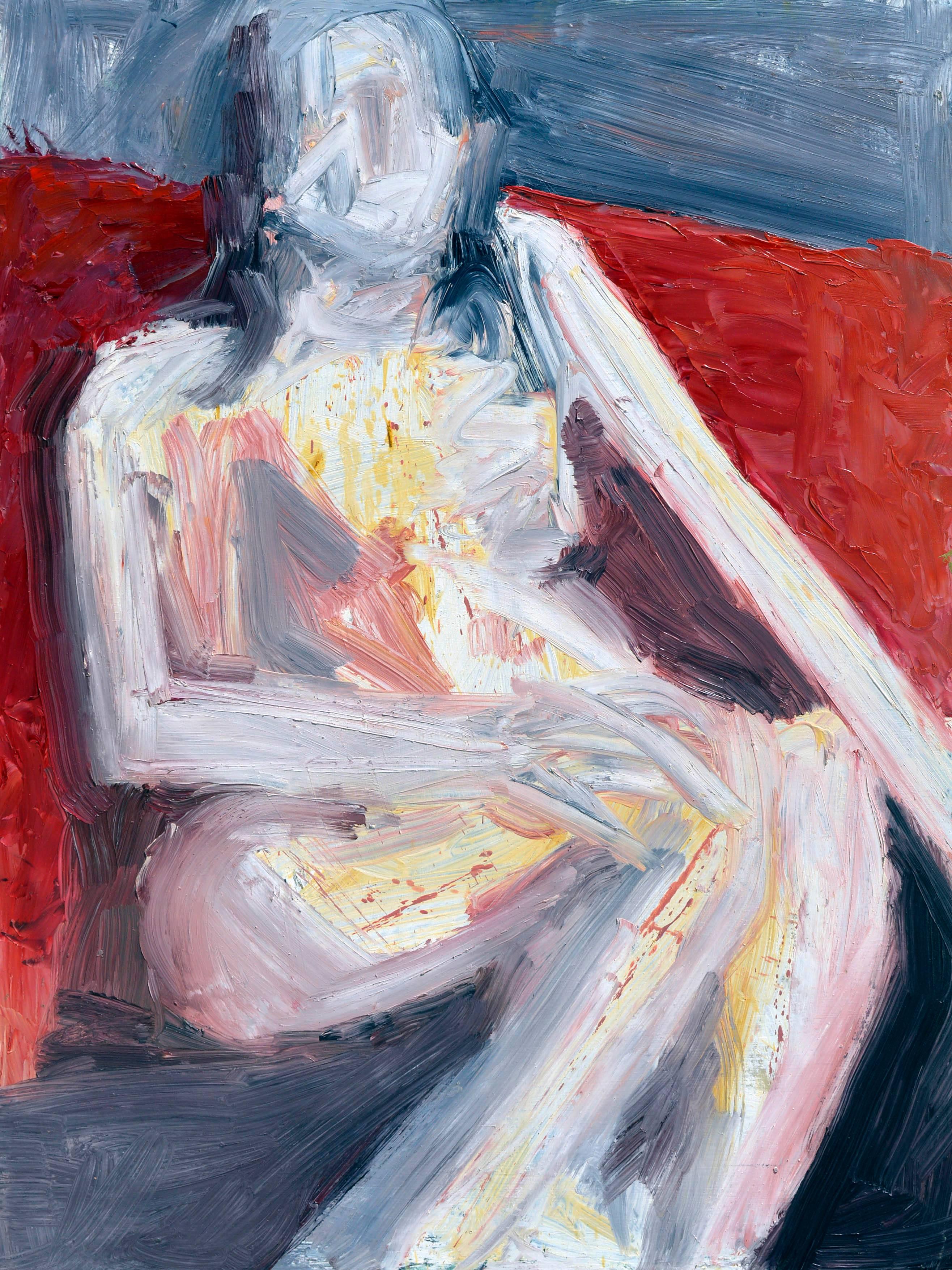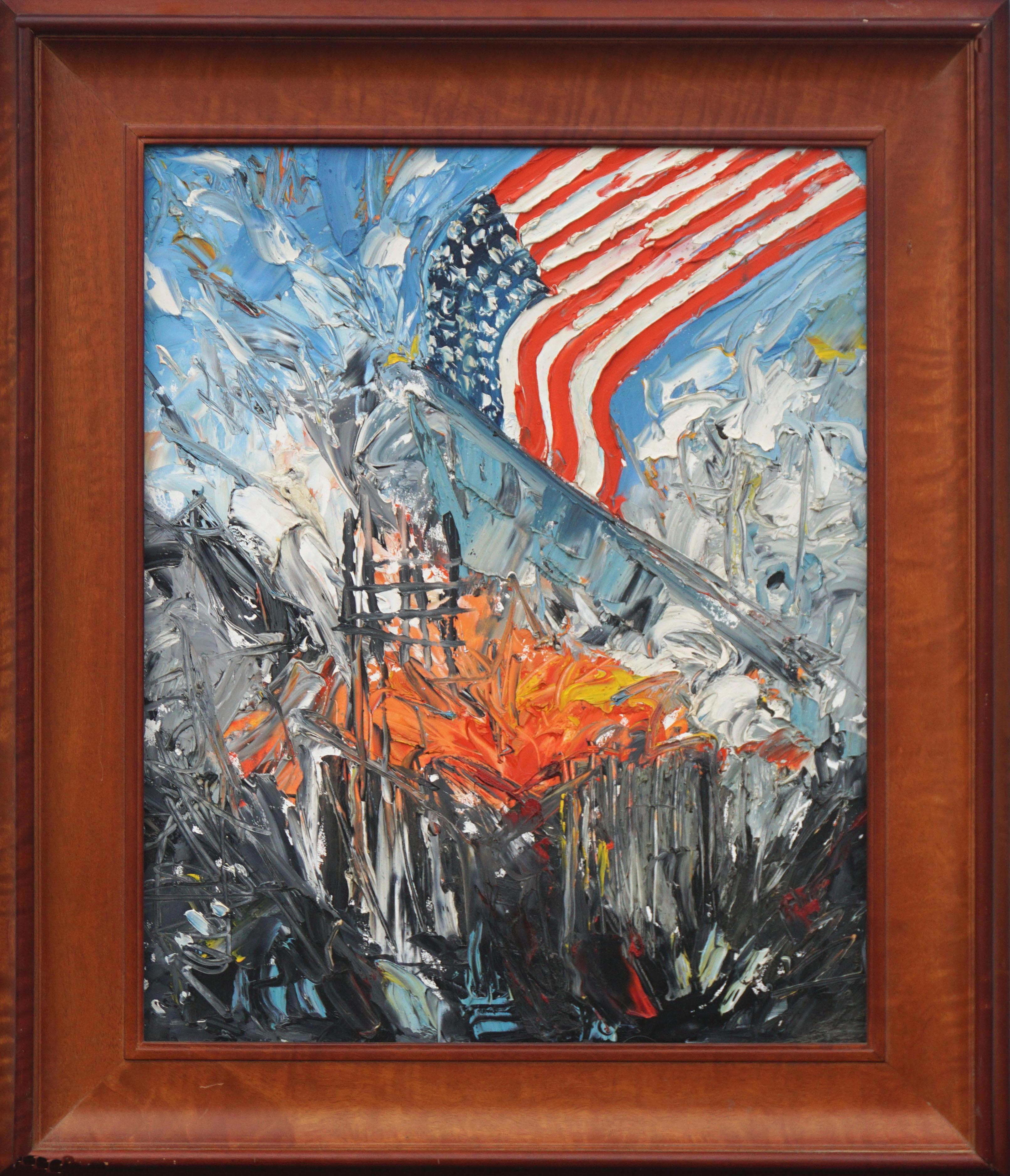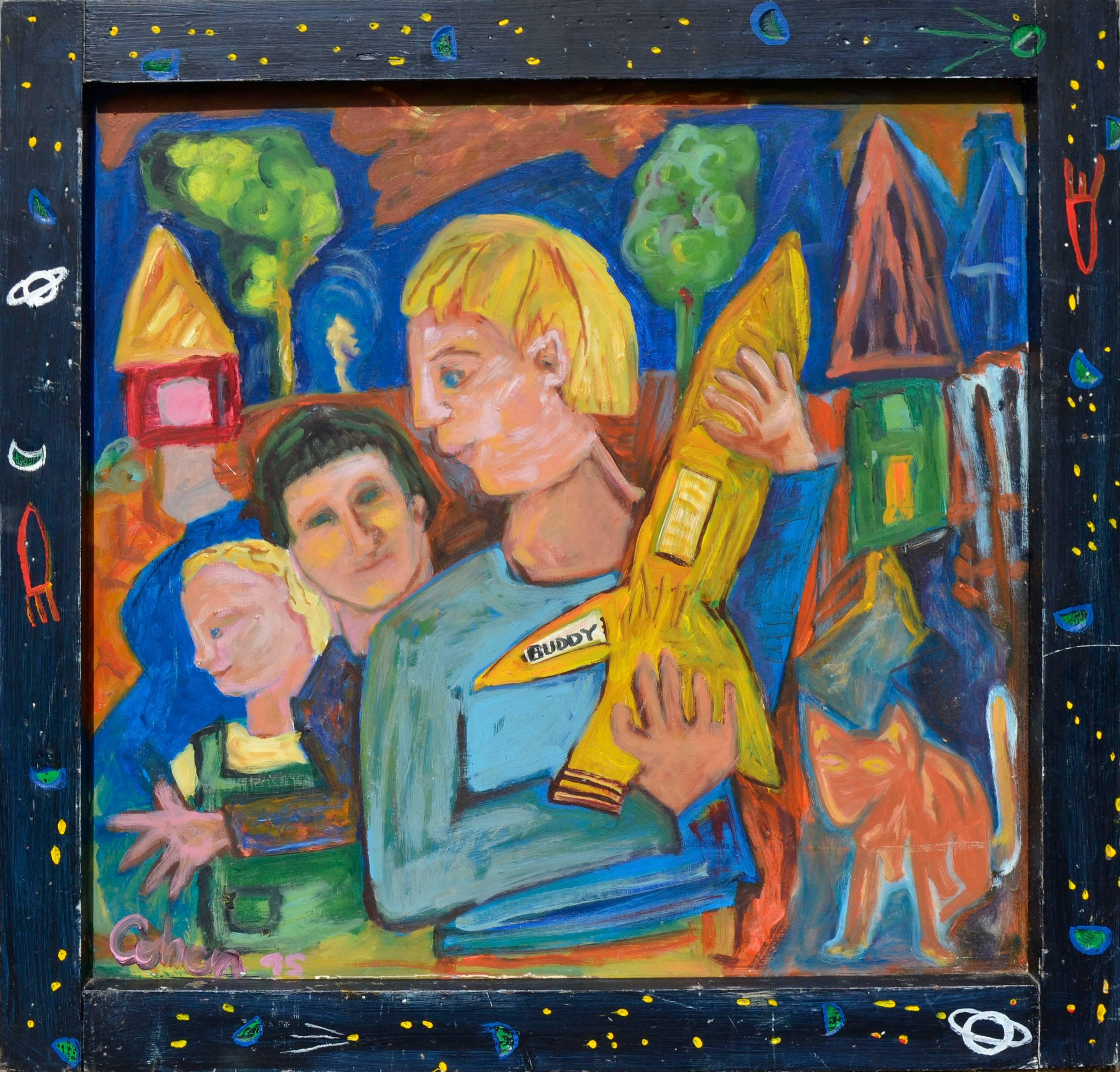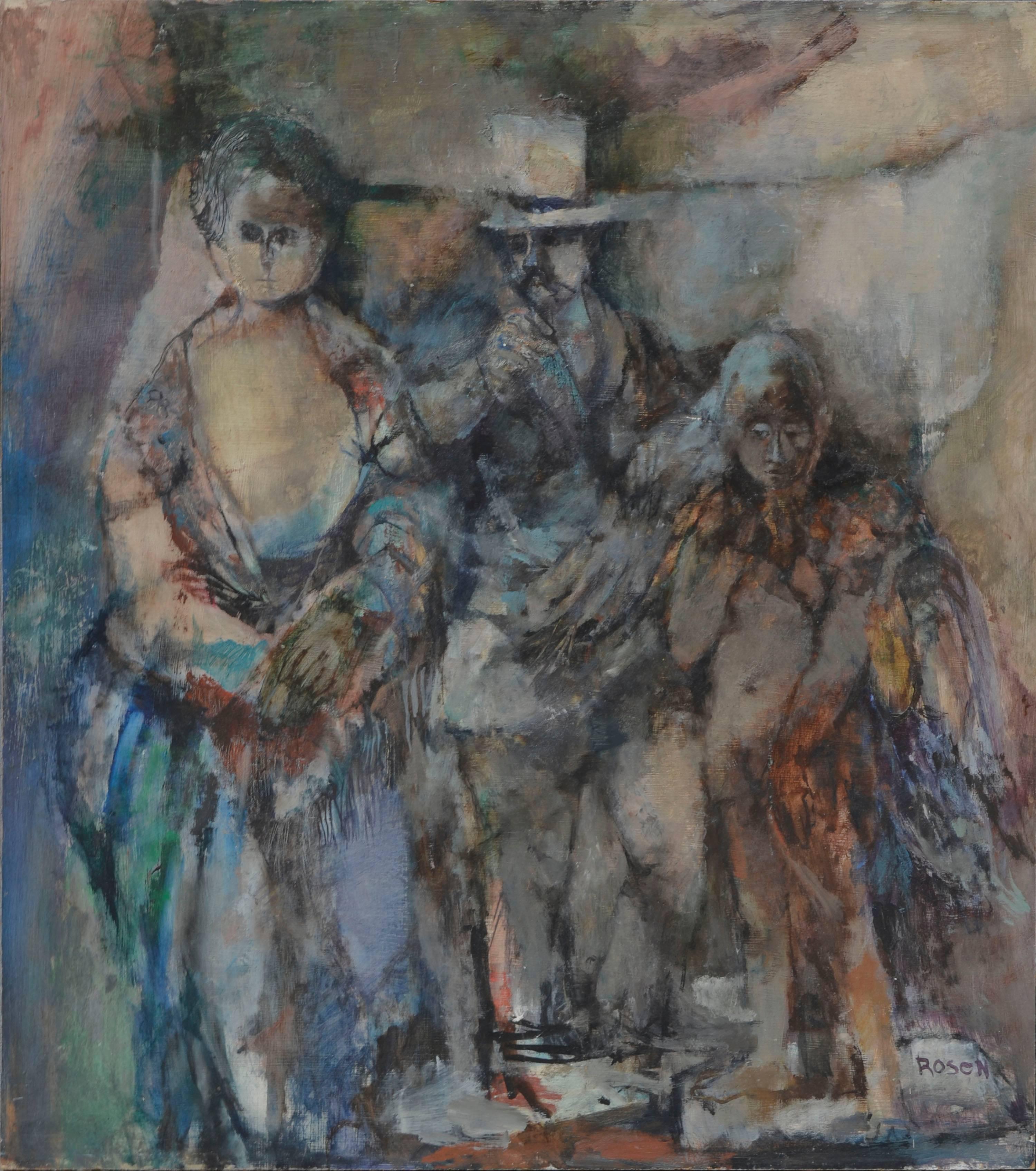Items Similar to Mother and Child
Want more images or videos?
Request additional images or videos from the seller
1 of 9
Bruno LucchesiMother and Childca. 1960
ca. 1960
About the Item
Bruno Lucchesi (b.1926). Mother and Child, ca. 1960. Oil and charcoal on sized paper mounted to masonite, measuring 11 x 21 inches; 15.5 x 25.5 inches in original gold leaf frame. Signed lower right. Excellent condition.
Born in 1926 in the village of Fibbiano Montanino, Lucca, Italy, Bruno Lucchesi has been called "the last of the Renaissance sculptors." As a boy, he worked as a shepherd, his first artistic imaginings demonstrated in designs he would carve out of sticks while tending the sheep. At ten years old, he left his home village to study at a monastery in Lucca, where he had his first exposure to sculpture as an art form.
After a few years, he returned home to work on the family farm, throughout the Second World War. During this time he met a Yugoslavian refugee artist, who took Lucchesi under his wing, teaching him the basics of drawing and encouraging him to pursue more formal training. Lucchesi did so, enrolling in the Art Institute of Lucca in 1947, and completing the classical training there in 1950. Subsequently, the twenty-four-year-old Lucchesi moved to Florence and continued to study sculpture, working for the Paternino Reproduction Company, where he made ceramic models of various types of figures for the tourist trade and invented a new technique termed sfoglia, used for creating realistic folds and texture in clothing.
He was appointed assistant professor of architecture at the Art Academy in Florence and so began a teaching career, which would continue in the United States, at the New School for Social Research and the National Academy of Design.
It was 1958 when Lucchesi, with his young wife and child, moved to New York City where his wife's parents lived. In his first year in America, Lucchesi worked a variety of jobs, finding little time for his own work and a scarcity of commission opportunities available. He took to making small sculptures in his spare time, which he began selling through his father-in-law's frame shop in Greenwich Village. His work soon found a faithful group of followers and he began to earn his living from sales of his artwork.
In 1959, Lucchesi won the Helen Foster Barnett Prize for Sculpture from the National Academy of Design and the following year had his sculpture "The Bather" selected for inclusion in the Whitney Annual, an annual exhibition of contemporary painting and sculpture at Whitney Museum of American Art. He returned to Florence, to focus exclusively on his work for one year, coming back to New York City in 1961 to a one-man show at the newly-opened Forum Gallery. His relationship with Forum Gallery would continue for the next several decades, with a total of nine solo exhibitions during that time span.
1962 brought Lucchesi a Guggenheim fellowship (1962-1963) and his first U.S. commission for a frieze at the National Westminster Bank USA of New York. The following decades included a succession of awards and prominent commission work, including four Gold Medals for sculpture: two from the National Academy of Design (1970, 1974), one from the National Arts Club (1963) and another from the National Sculpture Society (1977).
Commissioned sculptures by Bruno Lucchesi can be found at churches in Lucca, Italy, office buildings in Manhattan and various other locations throughout the U.S. and Italy. His work is included in the following collections: Brooklyn Museum, Brooklyn, NY; Columbia Museum, Columbia, South Carolina; Cornell University, Ithaca, NY; Dallas Museum of Art, Dallas TX; Hirshhorn Museum and Sculpture Garden, Smithsonian Institution, Washington, D.C.; National Academy of Design, New York, NY; Pennsylvania Academy of the Fine Arts, Philadelphia, PA; Utah Museum of Fine Arts, Salt Lake City, UT; and the Whitney Museum of American Art, New York, NY, among others.
- Creator:Bruno Lucchesi (1926, American)
- Creation Year:ca. 1960
- Dimensions:Height: 25.5 in (64.77 cm)Width: 15.5 in (39.37 cm)Depth: 1.5 in (3.81 cm)
- Medium:
- Movement & Style:
- Period:
- Condition:
- Gallery Location:Wilton Manors, FL
- Reference Number:1stDibs: LU245212458492
Bruno Lucchesi
Bruno Lucchesi was born in Fibbiano Montanino in Lucca, Italy, in 1926. He is an Italian-American sculptor known for his figurative work.. He studied at the Art Institute of Lucca, then moved to Florence, Italy, where he became an assistant professor at the University of Florence in 1953. In 1958, he moved to New York City and has since taught there at the National Academy of Design and the New School of Social Research. He continues to teach through workshops across the United States and Europe.
About the Seller
4.9
Platinum Seller
These expertly vetted sellers are 1stDibs' most experienced sellers and are rated highest by our customers.
Established in 2007
1stDibs seller since 2015
329 sales on 1stDibs
Typical response time: 1 hour
- ShippingRetrieving quote...Ships From: Wilton Manors, FL
- Return PolicyA return for this item may be initiated within 7 days of delivery.
More From This SellerView All
- Female DancerLocated in Wilton Manors, FLBeautiful mid-century painting of a female dancer by J. Steven. Oil on canvas measures 12 x 30 inches, 21 x 39 inches framed. Signed lower left with arti...Category
Mid-20th Century Abstract Figurative Paintings
MaterialsOil
- Fiddler and DancersLocated in Wilton Manors, FLShay Rieger (1923-1975). Fiddler and Dancers, 1975. Oil on canvas, 38 x 50 inches. Some ares of paint loss and flaking as documented in detail photos. No tears or punctures in canvas...Category
1970s Abstract Abstract Paintings
MaterialsOil
- Bubblegum GirlLocated in Wilton Manors, FLFantastic painting of a young girl blowing bubblegum. Oil on canvas, 24 x 32 inches; slightly larger in chrome frame. Signed illegibly lower right.Category
1970s Abstract Abstract Paintings
MaterialsCotton Canvas, Oil
- Tattoo Parlor Sailor (WPA era woman artist)By Helen MaltaLocated in Wilton Manors, FLHelen Malta (b.1912). Tattoo Parlor, ca. 1935. Oil on canvas, 20 x 33 inches. Signed lower right. Metropolitan Museum of Art reproduction rights stamp on r...Category
1930s Abstract Abstract Paintings
MaterialsCanvas, Oil
- Fisherman at DuskBy Oskar D'AmicoLocated in Wilton Manors, FLOskar D'Amico (1923-2003). Fisherman at Dusk, c.1960. Oil on linen canvas, 16 x 30 inches; 18 x 32 inches (frame). Signed lower right. Excellent condition with no damage or conservation. Biography: Oskar Maria D'Amico (February 22, 1923 – May 3, 2003) was an active Italian artist in Rome, Naples, Lanciano, Cisterna, Milan, Gallarate, Torino, Zagabria, Paris, Toulouse, Melun, Carenac, Maubeuge, Madrid, Barcelona, Zaragoza, Budapest, Győr, Mexico City, Cuernavaca, Morelia, Toronto, New York City, Philadelphia, Los Angeles, San Francisco, Miami, Denver, Santa Fe, Albuquerque and Socorro, between 1943 and 2003. He is considered a Nomad artist because of his ability to work in various styles. He had three major periods in his artistic life: Figurative, Materic and Geometric. [1]He also was an outstanding art director for more than 75 epic movies. D'Amico had a very outgoing personality. He was a non-conformist, which was reflected in his work throughout his life. D'Amico was born in CastelFrentano, Italy, a small village in Abruzzo. At a young age, he felt he had to leave and dive into the big world. After being a seminarist with the Salesiani during World War II, he left Naples, where he studied architecture, and began a great adventure in Rome. He specialized at the time in decorating nightclubs and bars, and invented a special type of double ceiling to hide the lights. D'Amico, who was self-taught as a teenager in drawing and painting, burst onto the filmmaking scene in Rome when an art director asked him to do a perspective of a set design. Soon other moviemakers were calling him.[2] D'Amico was an art director on 75 films including two by Orson Welles. D’Amico was able to create a real marble floor in the set of the palace of the King Saul, in "David and Goliath" directed by Orson Welles. Art directors previously painted a simulated marble on top of concrete due to the cost of the real thing. D'Amico became an associate of Jadran Films in ex-Yugoslavia, which specialized in Roman and Egyptian constructions. While an art director, he never stopped painting. His faceless clowns, reflecting the people who had no identity after World War II, were a big success. In the early 1960s, D'Amico moved with his family to Toronto, Canada, another place he felt was too small. He left for Philadelphia and New York City, which affected his work. He turned his focus to abstract, and for more than a decade created abstract Expressionist paintings "on the plane of all matter" that he called "Materic". The Materic style, which he invented, was done in several media and could not be changed once on the canvas. The paintings were very well received. D’Amico sold more than 400 in Philadelphia and New York City. Unfortunately he had to stop doing the Materics because the colors he used were harmful to his liver. In the mid 1970s, he returned to his architectural roots and developed a new vision for Abstract Constructivism using just acrylic colors. Presented in Paris by his French Art dealer, Francoise Tournier, at the Grand Palais de Paris, and in Mexico City, D'Amico's interpretation of the "New Geometry" was widely admired. In 1983, when he presented the work at the Bodley Gallery, people whispered that he had the potential to be the new Picasso because of his eclecticism and the Nomad nature of his styles. In 1987, D'Amico abandoned the gypsy life and settled in New Mexico. Albuquerque was the perfect place to dedicate himself 100 percent to his work.[3] There were no distractions and a good climate that reminded him of his beloved Cuernavaca in Mexico. Staying in close contact with his French art dealer Tournier, D’Amico had several shows in Denver at the Helen Karsh Gallery and in Albuquerque at the Black Swan and Café Galleries. At least once a year, D’Amico went to Europe to immerse himself in the antique world and visit museums and galleries. In 1992, visiting Tournier at the Castle of Saint Cirq Lapopie, he met the man who founded the MADI movement in 1940, Carmelo Arden Quin...Category
1960s Abstract Figurative Paintings
MaterialsCanvas, Oil
- Comes June (Surrealist Bride painting)By Nura UlreichLocated in Wilton Manors, FLNura Ulreich (1899-1950). June Comes, ca. 1935. Oil on sized panel. 24 x 30 inches; 26 x 32 inches framed. Metal leaf over wormy chestnut custom frame. Ex...Category
Mid-20th Century Abstract Figurative Paintings
MaterialsOil, Board
You May Also Like
- "7 Koi" Expressionist Brightly Colored Koi Underwater in Red/Yellow/Blue/GreenBy Linda HoltLocated in Wellesley, MA"7 Koi" is a complex work of koi fish swimming underwater filled with light and brilliant color painted in a lush and fluid style bordering on abstraction. Fish are in shades of ...Category
2010s Abstract Expressionist Figurative Paintings
MaterialsOil, Masonite
- Johann Strauss & Artie Shaw - Mid Century Modern AbstractBy Clark BlocherLocated in Soquel, CASwirling vortex of color and the words: "Johann Strauss' Tale(s) from the Vienna (Woods) Artie Shaw & Orchestra" by Kansas artist Clarke Blocher Unframed. I...Category
1960s Abstract Expressionist Abstract Paintings
MaterialsMasonite, Oil
- Abstract Expressionism --Seated Woman FigurativeBy Daniel David FuentesLocated in Soquel, CAFigurative abstract painting by San Jose, California area artist Daniel David Fuentes (American, 20th Century). San Francisco bay area abstract expressionist and landscape artist dur...Category
21st Century and Contemporary Abstract Expressionist Figurative Paintings
MaterialsMasonite, Oil
- America Rising - Patriotic 9/11 Figurative AbstractBy Jocelyn AudetteLocated in Soquel, CAVivid and evocative abstracted painting of 9/11 by artist Jocelyn Audette (American, b. 1952), circa 2001. Impasto adds texture and interest. Label on verso with artist's name. Pres...Category
Early 2000s Abstract Expressionist Abstract Paintings
MaterialsMasonite, Oil
- Rocket Boy Abstract Expressionist FigurativeBy Kristin CohenLocated in Soquel, CAA lighthearted figurative abstract by Bay Area artist Kristin Cohen (American, b.1963). Signed and dated lower left, "Cohen '95." Presented in the artist's painted wood frame. From ...Category
1990s Abstract Expressionist Figurative Paintings
MaterialsMasonite, Oil
- Victorian Couple with Angel - Figurative AbstractBy David Rosen (b.1912)Located in Soquel, CAMoody figurative abstract expressionist painting of a Victorian couple with an angel by artist David Rosen (American, 1912-2004), c. 1970. Signed "Rosen" lower right. Unframed. Image size: 30.25"H x 26.38"W. Born in 1912, Rosen grew up in Toronto, Canada before pursuing arts in the United States. Upon arriving, Rosen settled in New York City and attended the Cooper Union Art school in 1930. While participating in the Federal Arts Project, he worked for the program's mural department until 1941. He also worked with an artist collective, Siqueiros Art Workshop. There, Rosen met fellow FAP artist Jackson Pollack, and together, with artist Phillip Guston, they experimented with new painting techniques and mediums. Art movements are often reactions to the popular styles that precede them, and Abstract Expressionism applied a new and exciting method to Modern Art. Gradually, artists began to break away from an overly-studied, academic approach to painting and liberated their technique. During these workshops, Rosen was introduced to Pollack's groundbreaking "drip painting" before it changed the art world. As America became involved in World War II, the Federal Arts Project wound down, officially ending in 1942. Around this time, Rosen enlisted as a Merchant Seaman with the U.S Merchant Marines. During this time, he traveled to North Africa and Italy before concluding his service and moving to California where, in 1945, he devoted his full attention to building an art career. Within a couple of years, he landed a major exhibition at the Los Angeles County Museum of Art in 1947, and his first one-man show, which opened to rave reviews, was held at Hollywood's Contemporary Art Gallery. The exhibition’s success led to mural commissions from Palm Springs' Hotel del Tahquitz, and he scored more solo shows at West Hollywood's Chabot Gallery. The early 1950s brought a surge of recognition for Rosen's career, and while his work was certainly still influenced by Abstract Expression, his painting style included elements of Surrealism, Figurative Art, and Cubism. Like his colleague Jackson Pollack, Rosen produced work inspired by drip painting; however, rather than splattering, his drips were the natural flow marks from painting freely without regard for "mistakes." Throughout Rosen's long career, he would acquire techniques from vastly different art styles which made for a varied, eclectic catalog of work. Rosen continued to build his California art career and settled at a Laguna Beach art colony in 1958. There, he entered his work in the Laguna Beach Festival of Arts and was the first painter to contribute Abstract Art to the event. Rosen would participate in the festival for the next fifteen years. A year after his move, in 1959, Rosen opened his first studio gallery and began a 12-year collaboration with the Laguna Playhouse. For the next two decades, Rosen participated in 17 art exhibitions and 20 solo shows, and received considerable critical praise. Rosen's themes were as varied as his evolving painting style, and one of his themes focused on classic characters like Shakespeare's Hamlet. Rosen's close-up portraits of historical and literary figures, illustrated by the piece To Be or Not to Be: Soliloquy From Hamlet, capture the essence of the characters while remaining loose with the painting and even adding a slight cartoon feel. His ongoing Hamlet series, as a complete collection, makes an impact with the diversity of technique. Unlike the loose style of some of his works, the painting Madaam... that he is mad is true is influenced by the structure of Cubism, the flat dimensions of Byzantine Art, and his utilization of mixed media. After Rosen's death in 2004, the Laguna Beach Festival of Arts sponsored an exhibition of his Hamlet paintings at the Wells Fargo Building gallery. Throughout Rosen's career, he amassed a great deal of critical, industry, and public praise for his work. His beloved town of Laguna Beach bestowed numerous awards that include the Laguna Beach Annual Art Gallery Award and Orange County's Annual Exhibit Award. Rosen's work flourished in California, and he received recognition from the San Diego County Fair, Los Angeles' Miracle Mile...Category
1970s Abstract Expressionist Abstract Paintings
MaterialsMasonite, Oil
Recently Viewed
View AllMore Ways To Browse
Vintage Mother
Little Mother
Abstract Painting Figurative Mother
Mother And Child Signed
Study Of Young Child
Mother And Child Paintings
Abstract Mother Child
Mother Child Drawing
Mother And Child Oil
Mother And Child Oil Paintings
American Mother And Child Painting
Mother In Law
Columbia U
Lucca Italy
Mother And Child Mid Century
Parents And Child Sculpture
Childs Clothing
Mid Century Mother And Child Art
